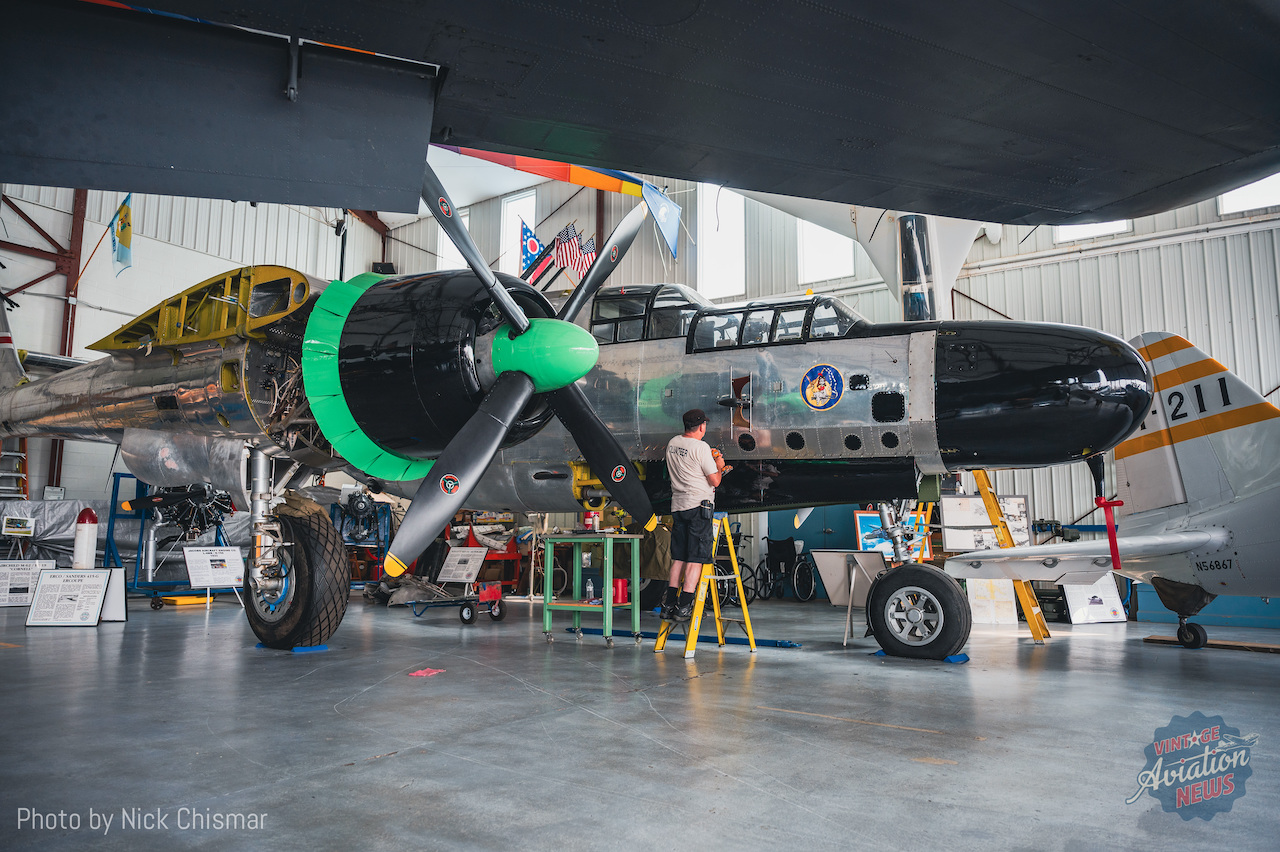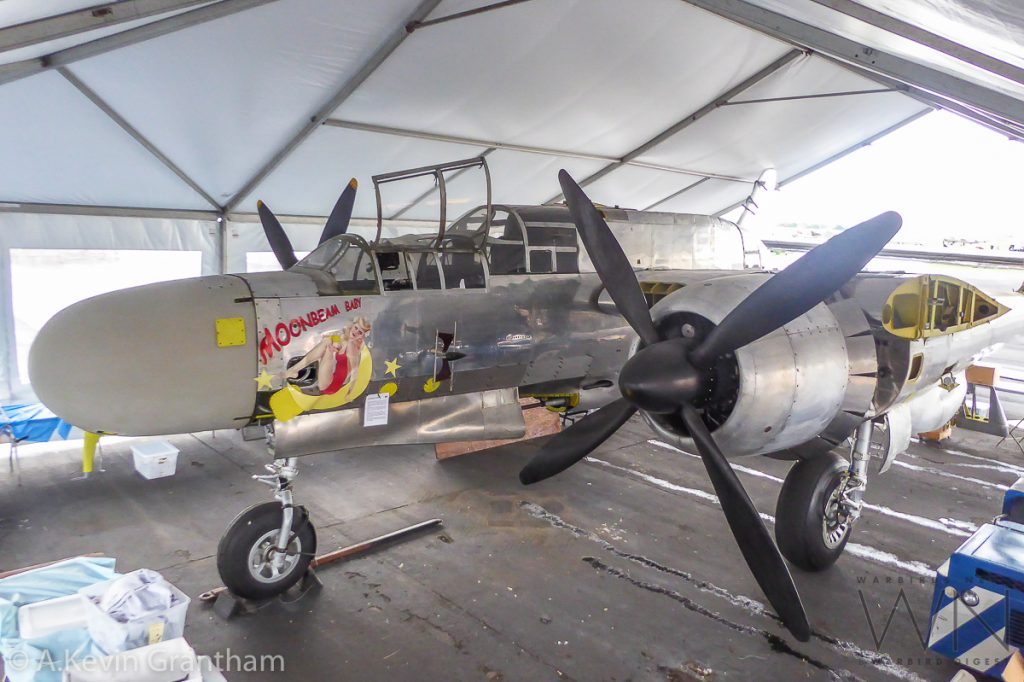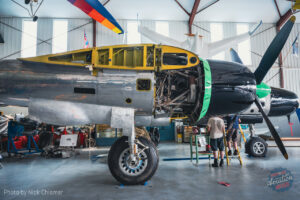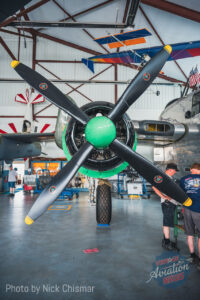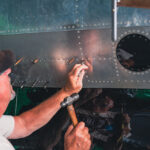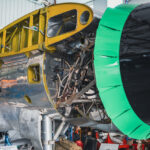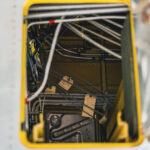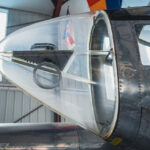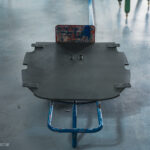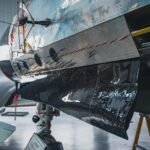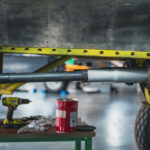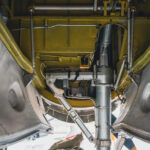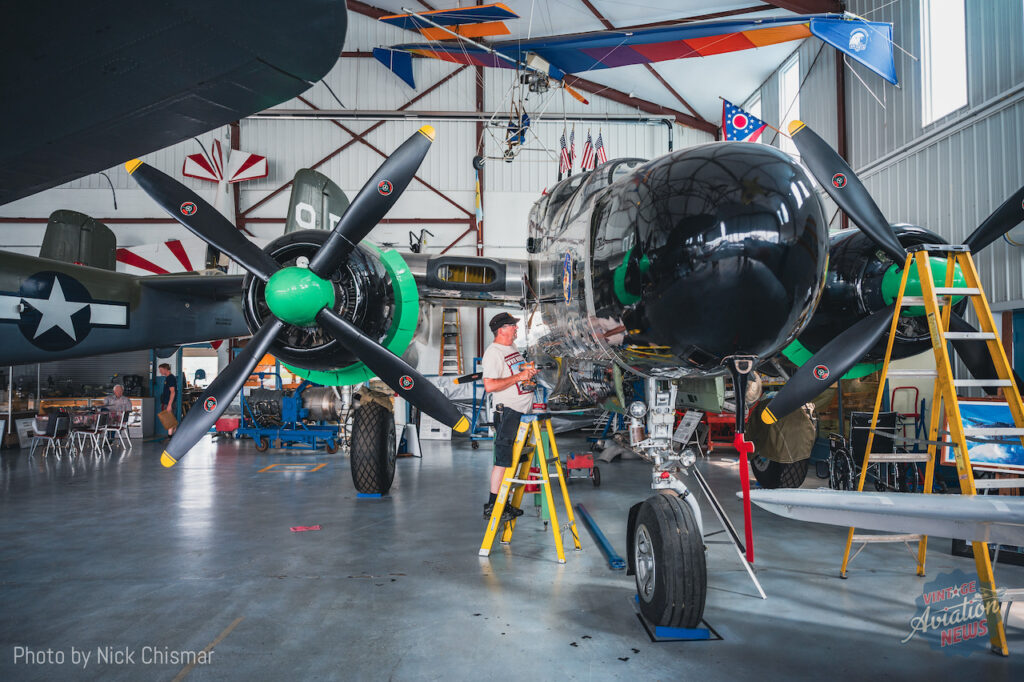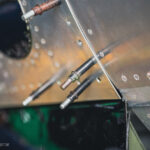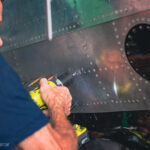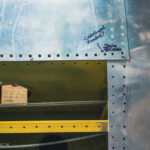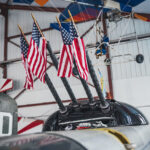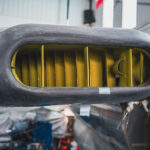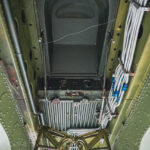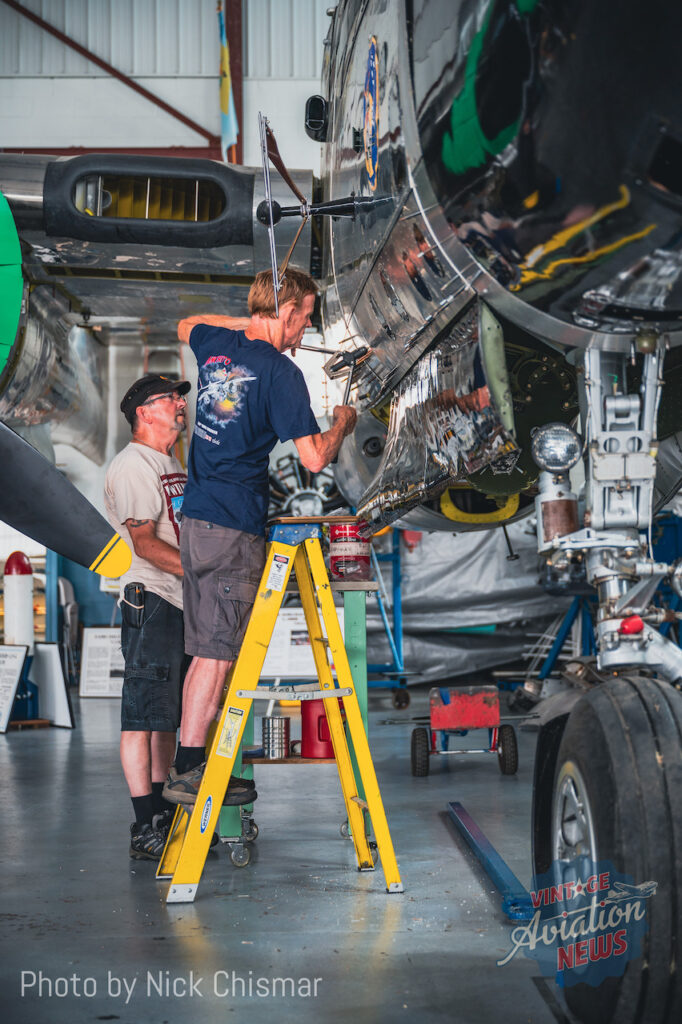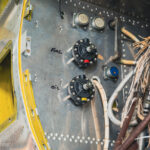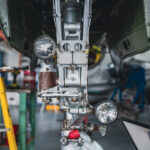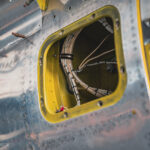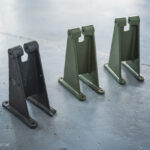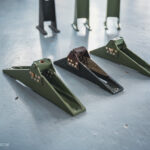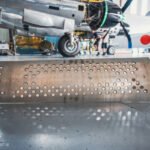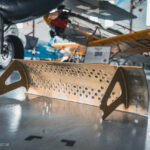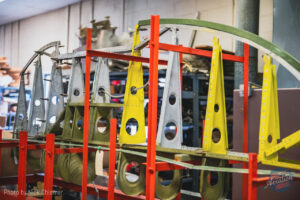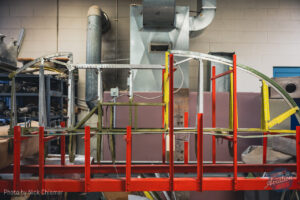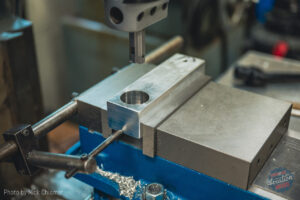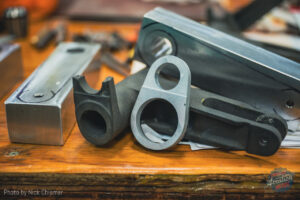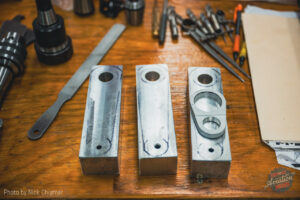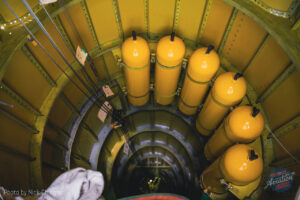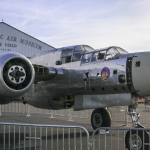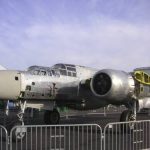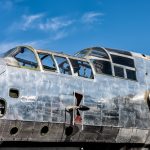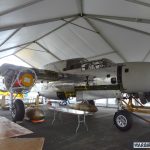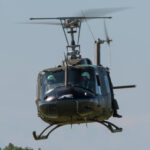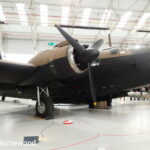by Nick Chismar
It has been a few years since we last reported on restoration progress with the Mid-Atlantic Air Museum‘s Northrop P-61B Black Widow (42-39445). As most of you will remember, a team from the museum recovered the aircraft from the side of Mount Cyclops in Hollandia, New Guinea during the late 1980s. They have made great strides in their effort to rebuild the WWII night fighter to airworthy condition, and we thought you would like to hear (and see) some of the work which has been going on with the Widow of late….
With their annual WWII Weekend event now in the rear view mirror and summer in full swing, many might imagine that personnel at the Mid-Atlantic Air Museum might be taking a well-earned rest, but that is not the case. Each day, a dedicated band of volunteers shows up to help rebuild the P-61, and their endeavor is clearly evident, as the images included here should reveal. I was lucky enough to visit the museum recently to get a good look at how their work is progressing. I also had the chance to discuss the project with museum president, Russ Strine.
Museum volunteers have accomplished a lot since our last update, but much of it lies within the airframe, out of view to visitors. For instance, the team has installed all new wiring harnesses running to and from the engines, switch panels, and instruments. The museum had to source numerous vintage wiring sockets and plugs as part of this task, which involved significant time and resources to complete. Furthermore, while the instrument panel itself is essentially ready to go, it has not been easy to source rebuildable examples of some of the instruments. Indeed, it took more than three years to find the necessary hydraulic gauges and overhaul them. Thankfully these were the last gauges they needed to fully populate the instrument panel.
With the wiring complete, the restoration team focused on the control cables. Unlike some aircraft from this period, which used torque tubes to position control surfaces, the P-61 is a fully cable-controlled aircraft, and has a seemingly endless number of cables and pulleys throughout the fuselage. Describing the issue, Russ Strine noted that: “Figuring out how all of the cables actually ran so they don’t conflict with each other and rub each other was a big deal.” Fortunately, the maintenance manuals have the requisite diagrams describing how everything goes together in great detail, which has allowed the museum to remanufacture and install the appropriate equipment in the fuselage and centre section. Even the cables for the outer wing panels are ready and awaiting installation once those components are completed.
The team has also finished rebuilding the nose gear doors and installed them, temporarily, on the aircraft. They were missing several of the hinges for this component, as they were destroyed when the aircraft crash-landed on Mount Cyclops during the war. Fortunately, however, the museum was able to salvage, restore and refit the appropriate fittings from a wrecked fuselage they have in storage. The aircraft’s oxygen tanks are also now installed in the engine nacelles.
The Black Widow’s dorsal machine gun turret is perhaps one of the design’s most iconic features. While the difficult task of finding one for the project was completed some 22 years ago, the owner wasn’t ready to part ways with it at the time. However, after years of negotiation, the museum was finally able to procure the turret a few years ago; they installed it this past March and it fits perfectly! Russ restored this turret himself, fitting four, custom-made replica (non-firing) .50 caliber machine guns to the original mounts and firing mechanisms. Aside from the guns, the completed turret will be fully operational, capable of elevating and rotating exactly as designed. To Russ, the turret completes the Black Widow’s menacing appeal.
Additional work in and around the aircraft’s nose is in the process of being completed. The team temporarily removed the P-61’s radar to finish up some of the details behind the armor plate. A few panels are being riveted back on and there is some minor fairing work awaiting completion. Once these steps are finished, the fuselage will be ready to hurdle its next significant milestone: repainting!
Work is continuing on the wings and control surfaces. The elevator is complete and now ready for installation, although that will not occur until next year due to the museum hangar’s limited available space (even with five aircraft not in their usual spots). The restoration team has begun rebuilding the first rudder, and has already made parts for the second rudder. Both units will comprise almost entirely new-build components, as the originals were too damaged to provide many useable parts.
The same can also be said for the outer wing panels. New spars have been completed, a process which took more than a year’s effort on its own. While the museum recovered both wings from the crash site, the accident severed one of them in half. The team has begun rebuilding the more intact unit, and has made parts for the other, but this aspect of the project will obviously be a hugely time-consuming process!
The final area which the museum must address in the aircraft’s rebuild involves its Pratt & Whitney R-2800-65W engines. The museum has both of the engines which came with the wreck, and has mounted the left-side example to the airframe temporarily to assist with fitting the cowlings, control linkages and wiring harnesses. However, the unit is seized and has proven difficult to disassemble for potential repair. The original right-side engine is in worse condition. It suffered an internal blower fire following the wartime crash, and this caused extensive, and likely irredeemable damage. Thankfully, the museum located a rebuildable replacement engine, complete with its mount, at an aircraft mechanics school in Fargo, North Dakota. When the time comes for their overhaul, Russ expects to send both engines to Anderson Aeromotive in Grandeville, Idaho. Russ believes that the total costs associated with rebuilding both engines and their accessories will approach US$250,000, which will obviously require a considerable fund-raising effort to meet.
The aircraft’s propellors appear to be in good shape; San Antonio Propeller Services will likely overhaul them due to their expertise in Curtiss Electric propellers. However, most post-war P-61/RF-15 firebomber operators swapped out the maintenance-heavy Curtiss Electric units in favor of modified Hamilton Standard propellers, such as those used on the F4U-4 Corsair. With this in mind, the museum has not yet decided which set of propellers to use.
While immense amounts of work have been expended on the project, there are still some areas of future concern. One of these issues involves the engines, which were rated for 2150 horsepower using wartime 115/140 grade fuel, a variety which has been unavailable since the 1970s. Today, warbird operators must use 100 octane low-lead fuel, which can reduce an aircraft’s original performance capabilities. As Russ told me when speaking about the museum’s B-25: “These engines will not operate to their rated takeoff manifold pressure with 100 octane…With 100 octane fuel, take off in this airplane would be 44-inches [manifold pressure]. We have had to pull it back to 39-inches because of detonation which burns the valves in the cylinders, so then you’d be changing a cylinder every couple times you fly it.”
While the P-61 might benefit from the use of its water-methanal injection system for added power, Russ is still concerned: “What is that going to do to this which has a 58-inch manifold pressure for takeoff? We will probably be going back to 40-inches or maybe lower than that. So all performance charts just get thrown out the window.” While optimism and excitement about the P-61 remain high, there must also be a level of caution regarding the future of 100LL fuel as well. Russ expressed this concern, noting: “It’s a foggy future as far as I’m concerned, and while I want to see this airplane fly, I’m not going to see it fly under risky circumstances.”
There is another potential roadblock ahead, albeit a smaller one. The P-61’s nose wheel requires a very rare 33” tire, which only the Lockheed Constellation also shares. Finding a reliable replacement for the one which the museum already owns is going to be a difficult task. While it may be possible to use a smaller wheel and tire combination, such as that from a B-25, a proper tire would be much preferred.
Overall, the Mid-Atlantic Air Museum’s restoration continues to make progress each day as they move towards having the world’s only flying P-61 Black Widow. Russ estimates that they have expended close to $900,000 on the aircraft’s restoration to date. From fundraising to volunteers – every bit of effort counts. As Russ told me: “We’re not a rich museum. We raise money dollar-by-dollar from our members and we do what we can. We’re fortunate that we have our own machine shop with very talented volunteers…” That talent and effort are clearly displayed inside the main hangar. Surrounded by the museum’s other incredible aircraft, work continues on the mighty P-61!
We would like to thank the Mid-Atlantic Air Museum for allowing Nick Chismar access to photograph the P-61 and machine shop, and a special thank you must go to Russ Strine for taking the time to sit down to discuss the restoration with Nick.







